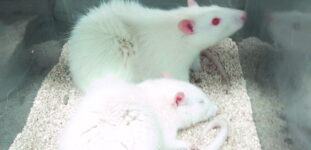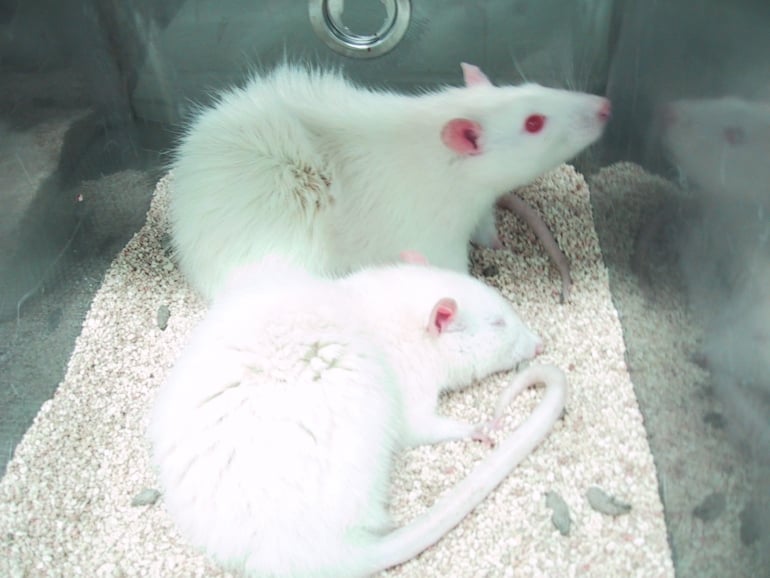
Rats Cut Open, Their Intestines Punctured for Cruel Sepsis Experiments
In cruel, useless procedures that attempt to investigate human sepsis, experimenters anaesthetise rats, mice, and other animals; cut open their abdomens; and puncture and squeeze their intestines to make faecal matter and bacteria leak out.


Afterwards, the animals are sewn back up. They regain consciousness and subsequently experience horrific symptoms such as crippling pain, multiple organ failure, and hypothermia. Eventually, they die.
This procedure – called caecal ligation and puncture – is widely used across the UK. It’s possible that hundreds of animals go through this horror every year right on our doorstep.
Who’s Carrying Out Cruel Sepsis Experiments?
British universities, including the University of Birmingham, King’s College London, the University of Nottingham, and Queen Mary University of London, along with experimenters from Imperial College London, are still conducting sepsis experiments on animals
At the University of Birmingham, experimenters were authorised to force tubing down the trachea of mice in order to deliver a substance that caused lung inflammation. They were also permitted to perform caecal ligation and puncture on mice. All animals were killed after the experiments.
At King’s College London, experimenters obtained permission to inject mice with a toxin in order to stimulate infection – only to kill them a few hours later.
At the University of Nottingham, experimenters injected mice with toxins and monitored the suffering of the extremely sick animals before killing them.
At Queen Mary University of London, experimenters were authorised to conduct sepsis experiments on mice – including injecting inflammatory toxins into their abdomens – before killing them. In one vicious experiment, they killed young mice, removed part their intestines, diluted the contents with water, and injected this mixture of faeces and water into conscious mice to induce sepsis.
Experimenters from Imperial College London were authorised to torment pregnant mice by puncturing their intestines in order to release faeces, which triggered early and often painfully long labour. Many pups and their mothers died as a result. These experimenters also injected an endotoxin into the pregnant mice, causing many to die from infection. Experimenters killed those who survived this torture by snapping their necks.
PETA has been in touch with British universities and provided them with detailed information about the futility of animal experiments. Moreover, we have shared our Research Modernisation Deal with them and urged them to move towards superior, non-animal methods that are relevant to sepsis in humans.


Experimenting on Animals Is Bad Science
Numerous scientific reviews demonstrate that caecal ligation and puncture is a deeply flawed procedure and irrelevant to finding cures for sepsis in humans.
In 2013, a landmark, decade-long study involving dozens of researchers from institutions across the US found that the results of sepsis experiments on mice can never be applied to humans. Why? It’s simple: the respective genetic responses to sepsis in the two species are completely different.
The study was so groundbreaking that Francis Collins, former director of the US National Institutes of Health – the world’s largest public funder of biomedical experiments – wrote, “No wonder drugs designed for the mice failed in humans: they were, in fact, treating different conditions!” Collins noted that 150 drugs successfully treated sepsis in mice but all later failed in human clinical trials. He called this disaster “a heartbreaking loss of decades of research and billions of dollars”.
Effective Sepsis Research
Luckily for humans and rats alike, there are revolutionary non-animal testing methods available around the world – which are not only more ethical but also effective in helping us understand how sepsis affects humans.
Cardiff University is working on Project Sepsis, which uses human data to develop computer-based methods for deciphering how humans can become infected and to identify effective treatments.
There’s also the University of Oxford’s decade-long Genomic Advances in Sepsis (GAinS) study, which more than 2,300 human patients have enrolled in. The study is working to uncover how the “structure and function of our genes can be used to inform our understanding of sepsis and, in the longer term lead to the development of new, effective treatments”.
Researchers have already made a number of important human-specific mechanistic discoveries that have been reported in the scientific literature.
What You Can Do
It’s not just sepsis experiments that fail humans and other animals. It has been estimated that a “novel drug can take 10 to 15 years and more than $2 billion to develop, and failure rates occur in about 95 percent of human studies”. Clearly, there is a problem with the current paradigm for developing and testing drugs and getting them onto the market, and experiments on animals are one of the contributing factors.
Animals aren’t test tubes. Please encourage the government to create a clear strategy for replacing animals in experiments. Sign our petition to support PETA’s Research Modernisation Deal. Lives of all species – ours included – depend on it.



